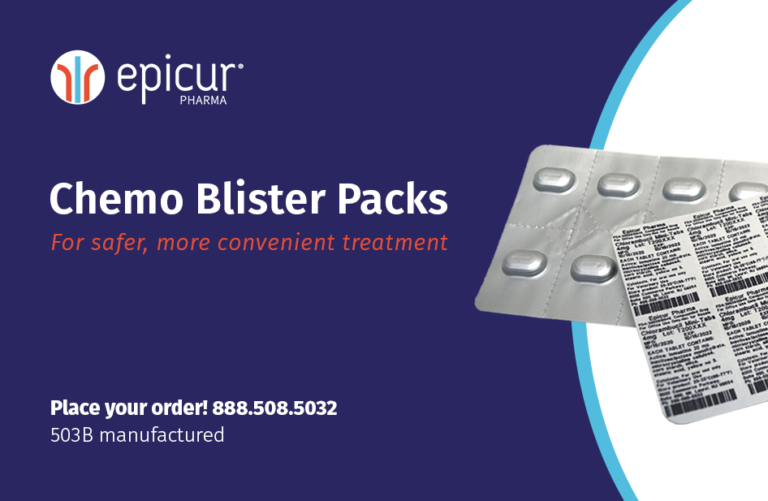As pet adoption rates rise and the diagnosis of cancer in pets increases, demand for cancer therapies is growing among pet caregivers. As a result, chemotherapeutic drugs are now more commonly used in veterinary clinics and hospitals. It also means more pet owners are administering chemotherapeutic treatments, such as chemotherapy tablets, in their homes.
While home administration provides convenience, these drugs are considered hazardous by the National Institute for Occupational Safety and Health (NIOSH) and safety cannot be overlooked. Using unit-dose blister packaging for the storage of chemotherapeutic tablets balances both safety and convenience for veterinary hospital and clinic staff as well as pet owners.
While the use of blister packaging has been commonplace among major human drug manufacturers for quite some time, it is now being incorporated into the compounding of veterinary chemotherapy tablets manufactured by FDA-registered 503B outsourcing facilities.
Benefits for Veterinary Hospitals and Clinics
In veterinary hospitals and clinics, reducing employee exposure to hazardous drugs is a priority to comply with the guidelines set in the United States Pharmacopeia (USP) General Chapter <800> Hazardous Drugs—Handling in Healthcare Settings. Unit-dose blister packaging for chemotherapeutic tablets makes it easier for veterinary hospitals and clinics to comply with USP <800>. The packaging minimizes procedural requirements and improves inventory management and prescription dispensing.
Key veterinary staff benefits include:
- Improved safety. Loose powder generated due to repeated handling of large containers of tablets poses exposure risks to employees through both skin contact and inhalation during tasks like manual pill counting. With blister packaging’s unit-dose containment system, employee exposure to the hazardous chemicals in chemotherapeutic medications is minimized.
- Reduced amount of personal protective equipment (PPE) needed to dispense or administer the product. When dispensing and administering certain medications on the NIOSH hazardous drugs list, veterinary hospitals and clinics do not need to apply several of the containment requirements of USP <800>. According to Table 5 of the NIOSH List of Antineoplastic and Other Hazardous Drugs in Healthcare Settings, 2016, drugs such as chemotherapy tablets in unit-dose blister packaging can be dispensed and administered with just one set of gloves as long as no further manipulation of the medication is needed; double chemotherapy gloves, a protective gown, eye/face protection, and respiratory protection are not required.
- Improved dispensing. Each unit-dose of the blister pack is labeled with the medication’s name, strength, expiration date, lot number, and is barcoded. This level of detail decreases the chance for dispensing errors. Pill count errors are eliminated and prescriptions can be filled more quickly because pill repackaging is not required.
- Enhanced inventory management. With each unit-dose fully labeled, it is easier to track inventory all the way down to a single dose level.
Benefits for Pet Owners and Patients
Pet owners and patients also benefit from the use of blister packaging for chemotherapy tablets in terms of therapeutic outcomes, safety, and convenience.
Advantages include:
- Medication error reduction. It is much more difficult for double-dosing errors to occur when a pet owner is using individually packed tablets compared with a bottle of 30 tablets. Because each blister pack dose is labeled with the drug name and strength, it’s also more difficult to mix up medications. Even with tablets of similar size and color, patient safety has a higher level of protection with blister packaging.
- Improved adherence. When medications are blister packed it’s easier to see if a dose has been taken or skipped. Improved adherence can improve clinical outcomes and decrease unwanted side effects.
- Increased child safety. The multi-step process required to open a blister pack unit makes it difficult for small children in the client’s home to access the medication. If access does occur, the level of exposure is minimized to one tablet instead of multiple tablets, as could occur with a bottle containing several pills.
- Minimization of pet owner contact with hazardous chemicals. When tablets are in a bottle, they are constantly coming into contact with each other and generating hazardous powder residue as a result. With blister packaging, powder production is significantly reduced because tablet de-dusting is done during both the compression and blistering process. Additionally, each pill is protected in its own securely enclosed cavity, making the product safer to handle. This unit-dose storage mechanism also means clients can avoid fumbling with, and possibly spilling, an entire bottle of hazardous pills, reducing exposure levels and surface contamination if a spill does occur.
- Improved portability. Compared with a bulky bottle, streamlined blister packaging is more convenient to carry. This allows pet owners the flexibility of carrying the exact number of doses needed. The risk of accidental spills in a purse or in luggage is also greatly reduced, making it a safer option for travel as well.
Epicur Pharma is pleased to be one of the first 503B outsourcing facilities to transition to the use of blister packaging for all of our chemotherapy tablets.
Contact us to place your order today.
Want more info on blister packs?
Here are a few more good reads that further explain the use and benefits of blister packaging:
If you have more questions or you’re ready to place an order, we’re here to help and look forward to partnering with you!



